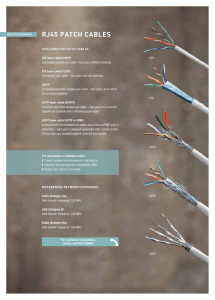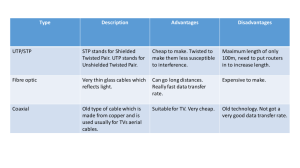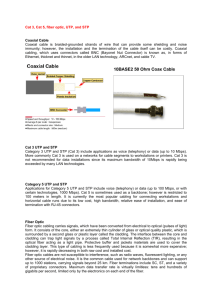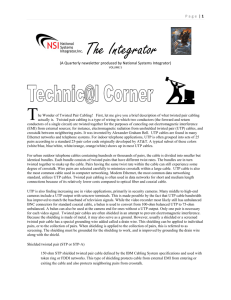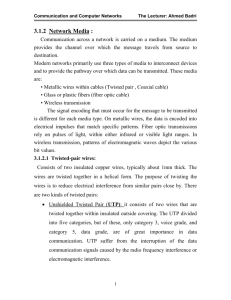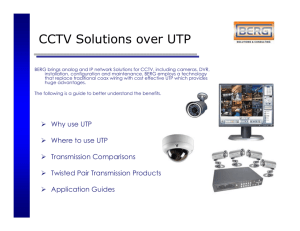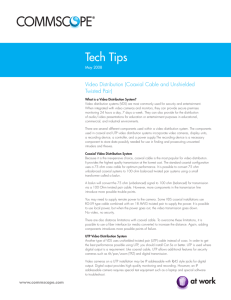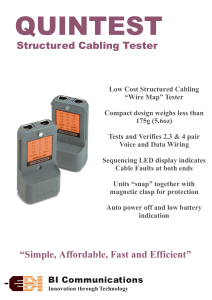Introduce: What is Network Cabling? Cable is the medium through
advertisement
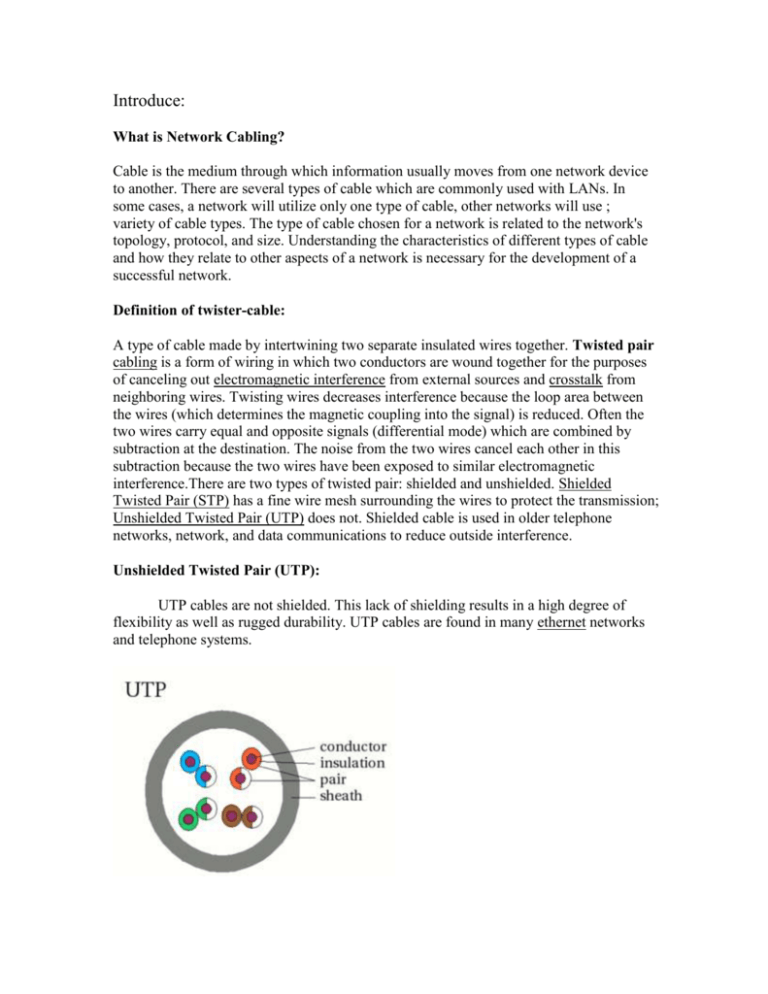
Introduce: What is Network Cabling? Cable is the medium through which information usually moves from one network device to another. There are several types of cable which are commonly used with LANs. In some cases, a network will utilize only one type of cable, other networks will use ; variety of cable types. The type of cable chosen for a network is related to the network's topology, protocol, and size. Understanding the characteristics of different types of cable and how they relate to other aspects of a network is necessary for the development of a successful network. Definition of twister-cable: A type of cable made by intertwining two separate insulated wires together. Twisted pair cabling is a form of wiring in which two conductors are wound together for the purposes of canceling out electromagnetic interference from external sources and crosstalk from neighboring wires. Twisting wires decreases interference because the loop area between the wires (which determines the magnetic coupling into the signal) is reduced. Often the two wires carry equal and opposite signals (differential mode) which are combined by subtraction at the destination. The noise from the two wires cancel each other in this subtraction because the two wires have been exposed to similar electromagnetic interference.There are two types of twisted pair: shielded and unshielded. Shielded Twisted Pair (STP) has a fine wire mesh surrounding the wires to protect the transmission; Unshielded Twisted Pair (UTP) does not. Shielded cable is used in older telephone networks, network, and data communications to reduce outside interference. Unshielded Twisted Pair (UTP): UTP cables are not shielded. This lack of shielding results in a high degree of flexibility as well as rugged durability. UTP cables are found in many ethernet networks and telephone systems. Shielded Twisted Pair (STP): STP cabling includes metal shielding over each individual pair of copper wires. This type of shielding protects cable from external EMI (electromagnetic interferences). e.g. the 150 ohm shielded twisted pair cables defined by the IBM Cabling System specifications and used with token ring networks. Screened Shielded Twisted Pair (S/STP): S/STP cabling, also known as Screened Fully shielded Twisted Pair (S/FTP)[1], is both individually shielded (like STP cabling) and also has an outer metal shielding covering the entire group of shielded copper pairs (like S/UTP). This type of cabling offers the best protection from interference from external sources. Screened Unshielded Twisted Pair (S/UTP): S/UTP, also known as Fully shielded (or Foiled) Twisted Pair (FTP), is a screened UTP cable. S/UTP, also known as Fully shielded (or Foiled) Twisted Pair (FTP), is a screened UTP cable. Advantages of UTP: Although UTP was once considered to be slower at transmitting data than other types of cable, this is no longer true. In fact, UTP is considered the fastest copper-based medium today. The following summarizes the features of UTP cable: Speed and throughput—10 to 1000 Mbps Average cost per node—Least expensive Media and connector size—Small Maximum cable length—100 m (short) Types of UTP cabling are as follows: Category 1—Used for telephone communications. Not suitable for transmitting data. Category 2—Capable of transmitting data at speeds up to 4 megabits per second (Mbps). Category 3—Used in 10BASE-T networks. Can transmit data at speeds up to 10 Mbps. Category 4—Used in Token Ring networks. Can transmit data at speeds up to 16 Mbps. Category 5—Can transmit data at speeds up to 100 Mbps. Category 5e —Used in networks running at speeds up to 1000 Mbps (1 gigabit per second [Gbps]). Category 6—Typically, Category 6 cable consists of four pairs of 24 American Wire Gauge (AWG) copper wires. Category 6 cable is currently the fastest standard for UTP. The following summarizes the features of STP cable: Speed and throughput—10 to 100 Mbps Average cost per node—Moderately expensive Media and connector size—Medium to large Maximum cable length—100 m (short) When comparing UTP and STP, keep the following points in mind: The speed of both types of cable is usually satisfactory for local-area distances. These are the least-expensive media for data communication. UTP is less expensive than STP. Because most buildings are already wired with UTP, many transmission standards are adapted to use it, to avoid costly rewiring with an alternative cable type.
